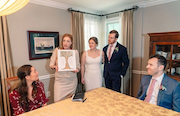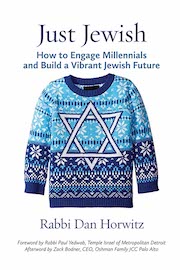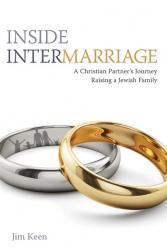After October 7
The JTA Teen Fellowship produced an excellent article, “For teens in interfaith families, the war in Gaza can be a stress test of their Jewish identities,” that describes the experiences of three Jewish teens from interfaith families. Fern Chertok, a leading researcher on interfaith families, said “[b]eing able to learn from different viewpoints is often a dividend for teens from interfaith families… They are the natural bridge builders.” Rabbi Jessica Lowenthal, who works with teens from interfaith families as director of her congregation’s religious school, made the most important point – she “doesn’t see a difference between how interfaith families or other Jewish families relate to Israel, given the disagreements and diverse upbringings among Jews.”
![]() The JFNA staff responsible for a new JFNA survey described in eJP “newfound interest in Jewish life” after October 7, describing a “Surge” of people showing up who previously were not very engaged and who are “craving community.” The authors say this “explosive increase in interest and engagement … is an opportunity and responsibility of historic proportions;” a key response is to “increase belonging,” more training in relational engagement for staff and volunteers, more notice and welcome of everyone. So far, no data has been released on whether the Jewish engagement of Jewish respondents was affected by how their partners who are not Jewish feel in Jewish settings.
The JFNA staff responsible for a new JFNA survey described in eJP “newfound interest in Jewish life” after October 7, describing a “Surge” of people showing up who previously were not very engaged and who are “craving community.” The authors say this “explosive increase in interest and engagement … is an opportunity and responsibility of historic proportions;” a key response is to “increase belonging,” more training in relational engagement for staff and volunteers, more notice and welcome of everyone. So far, no data has been released on whether the Jewish engagement of Jewish respondents was affected by how their partners who are not Jewish feel in Jewish settings.
New York Community Study
![]() The UJA-Federation of New York federation released the New York 2023 Jewish Community Study, discussed in the New York Jewish Week and in eJP.
The UJA-Federation of New York federation released the New York 2023 Jewish Community Study, discussed in the New York Jewish Week and in eJP.
The JTA story only noted that “The rate of intermarriage is lower in New York than among Jews in the rest of the country.” While the overall percent of New York married couples who are intermarried is 37%, it is 46% of all non-Orthodox couples, and 57% of non-Orthodox couples who are 30-49 years old (compared to 34% of those who are 65+).
The eJP report quotes Ira Sheskin as attributing the 6% growth in Jewish households since the last survey in 2011 “in part to interfaith marriages” – “If two Jews marry one another, you get one Jewish household. If two Jews marry non-Jews, you get two Jewish households.”
The study found that 16% of adults in intermarried families report they are raising their children Jewish and 5% Jewish and something else (compared to 96% and 0% respectively in in-married families). Emily Sigalow, one of the study’s directors, is quoted in the eJP story as saying “a lower percentage of interfaith couples said they raised their children Jewish than expected… In other big Jewish communities like Los Angeles and Chicago, there are higher percentages [of people saying their children are Jewish]…” Sigalow “attributed the difference to how pollsters phrase the questions: ‘We asked about how children are raised, whereas others asked about their Jewish identity.’”
Importantly, as to 20% of the children in intermarried families, and 27% of the children in those families under three years of age, the parents have not decided yet on religious upbringing – representing a big opportunity. Moreover, 44% of adults in intermarried families reporting they are raising their children as “none of the above” – yet 66% of those families celebrate Hanukkah and 62% attend a Passover seder. This illustrates the lack of clarity and consistency around what it means to raise a child Jewish, or Jewish and something else, or neither of those choices.
However, only 27% of intermarried households with children held a Jewish naming ceremony, and only 17% have had or are planning to have a bar or bat mitzvah. The low figure for naming ceremonies is understandable given the large percentage of undecideds with younger children, but the low figure for bar/bat mitzvah, when children obviously are older, is concerning.
The study asked questions about the reasons people did not attend religious services, but unlike some other local community studies, did not give as a possible answer not feeling welcome.
Finally, the study asked respondents how important it would be that their grandchildren be Jewish and marry someone Jewish. They conclude from the answers that Jewish New Yorkers feel that “Jewish continuity is important” – suggesting, wrongly I would say, that marrying someone Jewish is necessary for Jewish continuity. In fact, intermarrieds in the survey understood this: while 42% said it was important that their grandchildren be Jewish, only 17% said it was important that their grandchildren marry someone Jewish.
Progress
In March I wrote that Noah Feldman’s new book To Be a Jew Today offers A Fresh Perspective on Interfaith Marriage. This month an article in the Harvard Law Bulletin (where Feldman teaches) says he “explores the tension in discouraging intermarriage amid societal expectations that we should be free to marry whomever we happen to love, writing that ‘there is something troubling about saying that I can only love someone if the person is part of my Us, not if the person is part of my Them.’”
![]() Samir Mehta’s “For American Jews, interfaith weddings are a new normal – and creatively weave both traditions together” is a very pleasant recounting of the ways interfaith couples incorporate their families’ traditions. At the end, under the heading “Tough conversations,” she writes that “Not everything is fun and easy in the world of interfaith weddings.” Couples who she interviewed told her stories about their weddings – but some were about rabbis who would not officiate for them, or family members who disapproved. But she concludes, “Overall, however, most people’s weddings were happy memories that offered hints to the interfaith lives and household that they would go on to create together.”
Samir Mehta’s “For American Jews, interfaith weddings are a new normal – and creatively weave both traditions together” is a very pleasant recounting of the ways interfaith couples incorporate their families’ traditions. At the end, under the heading “Tough conversations,” she writes that “Not everything is fun and easy in the world of interfaith weddings.” Couples who she interviewed told her stories about their weddings – but some were about rabbis who would not officiate for them, or family members who disapproved. But she concludes, “Overall, however, most people’s weddings were happy memories that offered hints to the interfaith lives and household that they would go on to create together.”
 The second (perhaps annual?) Re-CHARGING Reform Judaism conference is being held May 29 and 30. As I wrote last year, although one of the motivations for the gathering then was “lagging Reform synagogue attendance and declining revenues,” nothing was said about inclusion of interfaith families as a way to reverse declining enrollment. I was pleased to see that this year, 18Doors’ Jodi Bromberg is a panelist, and I hope to report on what was said next month.
The second (perhaps annual?) Re-CHARGING Reform Judaism conference is being held May 29 and 30. As I wrote last year, although one of the motivations for the gathering then was “lagging Reform synagogue attendance and declining revenues,” nothing was said about inclusion of interfaith families as a way to reverse declining enrollment. I was pleased to see that this year, 18Doors’ Jodi Bromberg is a panelist, and I hope to report on what was said next month.
Also in the news:
- In a positive development from Israel, the Supreme Court ruled that non-Orthodox conversions conducted in Israel would be recognized for purposes of Israeli citizenship. Previously, non-Orthodox conversions outside of Israel were recognized, but not those conduced in Israel. One leading political figure “welcomed the ruling, saying, ‘We all need to live here in mutual tolerance and respect.’”
- A report of a presentation by Dr. Tatjana Lichtenstein, a professor at the University of Texas, on the experiences of intermarried families in the Holocaust.
- PRRI published a survey on “Family Religious Dynamics and Interfaith Relationships” but unfortunately did not report any data on Jews or Jewish families.

 Laurel Snyder, an award-winning author of children’s books who grew up with a Jewish father and a Catholic mother, wrote a beautiful
Laurel Snyder, an award-winning author of children’s books who grew up with a Jewish father and a Catholic mother, wrote a beautiful  Coincidentally, JTA had an earlier interesting
Coincidentally, JTA had an earlier interesting  More stories are starting to appear about the impact on people in interfaith relationships of Israel’s war against Hamas and increasing expressions of antisemitism. In “
More stories are starting to appear about the impact on people in interfaith relationships of Israel’s war against Hamas and increasing expressions of antisemitism. In “ What we appreciated about the book is the matter-of-fact acknowledgment of the prevalence of interfaith relationships and seeing them as an opportunity. This starts with the Introduction: “Jewish Millennials are globally connected, have mostly non-Jewish friends, and are living in interfaith households at an incredibly high clip (whether as products of an interfaith marriage and/or in one themselves).” Or the book’s end, “For those concerned about Jewish continuity, the math argues for viewing interfaith marriages as a Jewish communal growth opportunity.”
What we appreciated about the book is the matter-of-fact acknowledgment of the prevalence of interfaith relationships and seeing them as an opportunity. This starts with the Introduction: “Jewish Millennials are globally connected, have mostly non-Jewish friends, and are living in interfaith households at an incredibly high clip (whether as products of an interfaith marriage and/or in one themselves).” Or the book’s end, “For those concerned about Jewish continuity, the math argues for viewing interfaith marriages as a Jewish communal growth opportunity.”